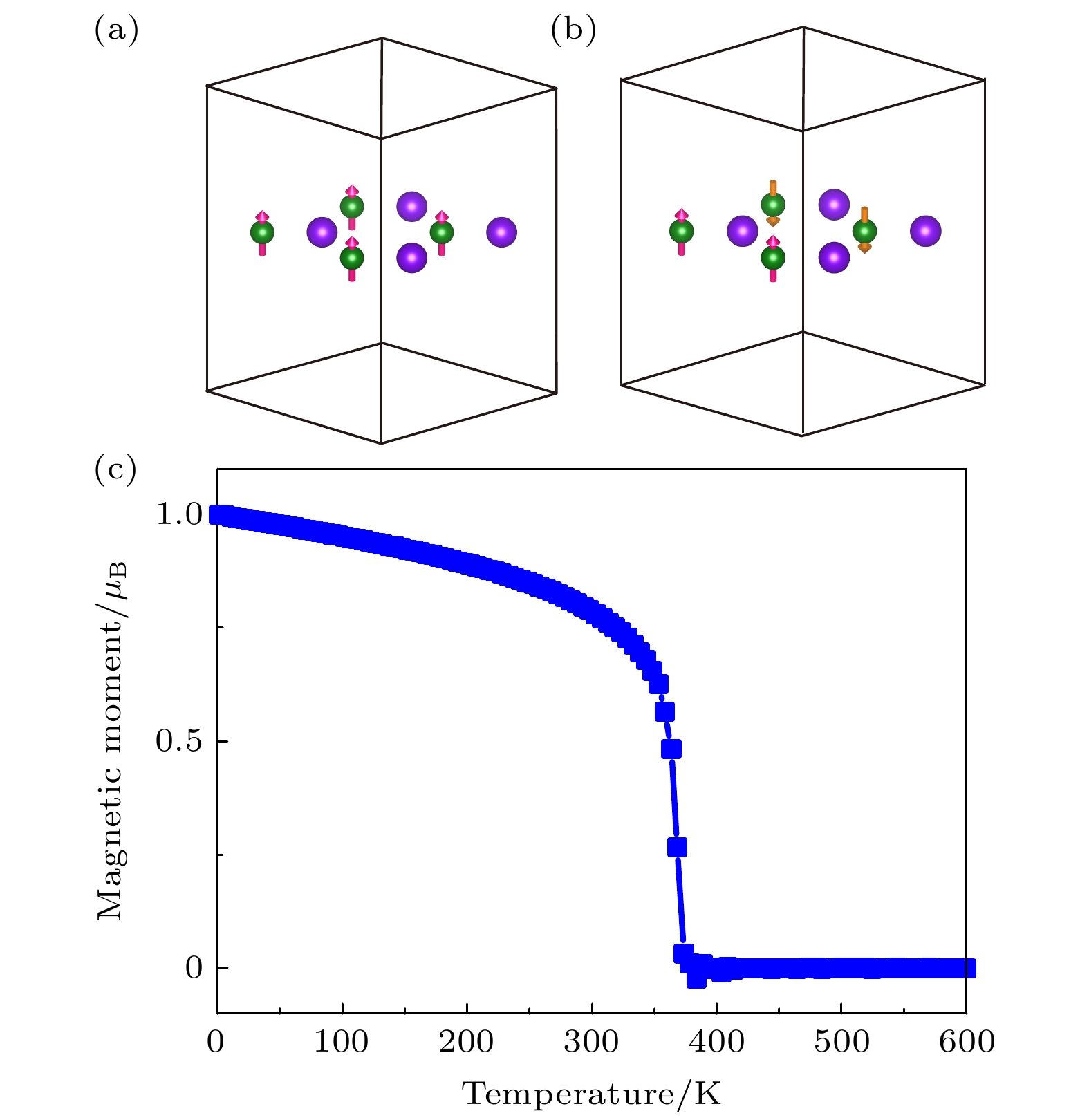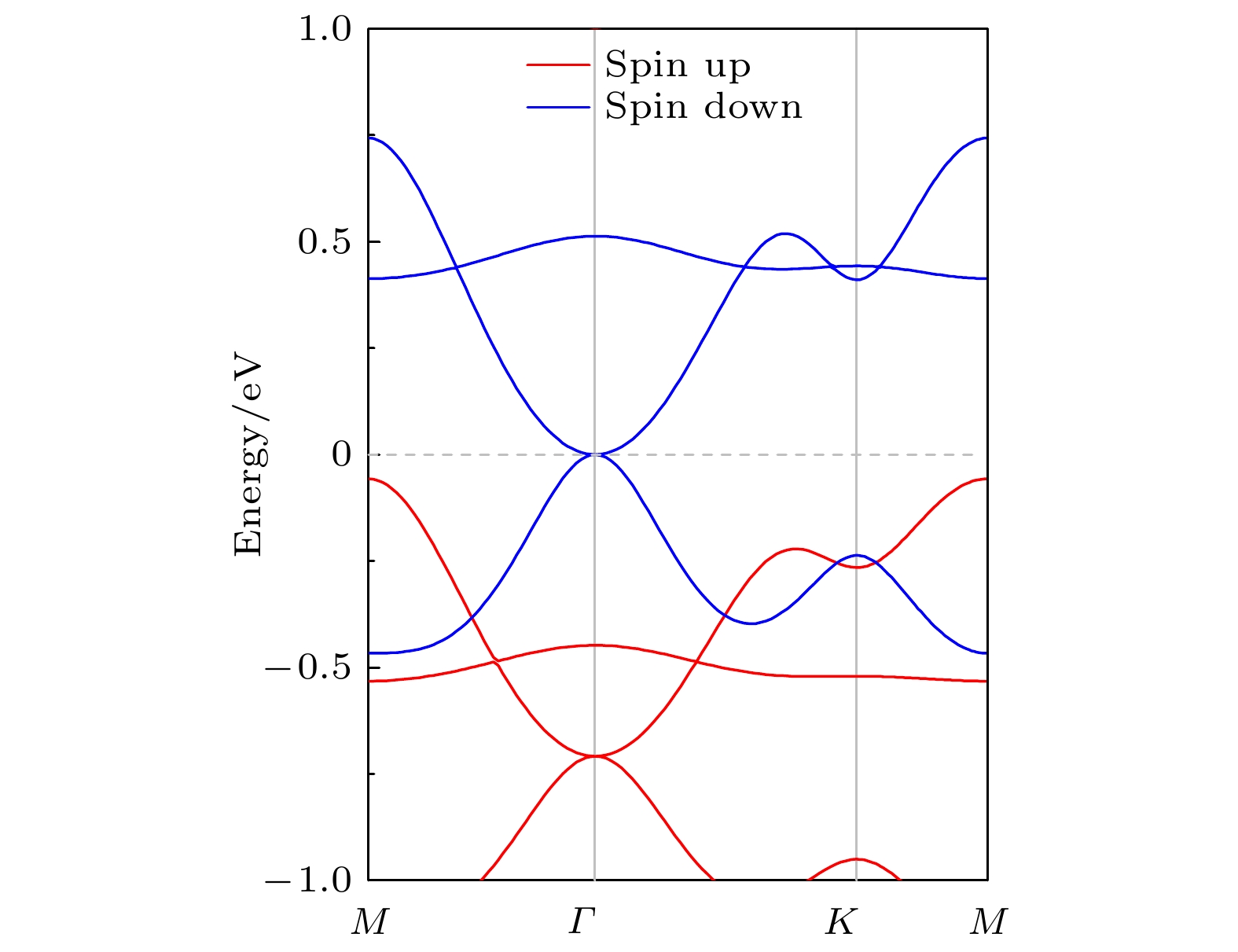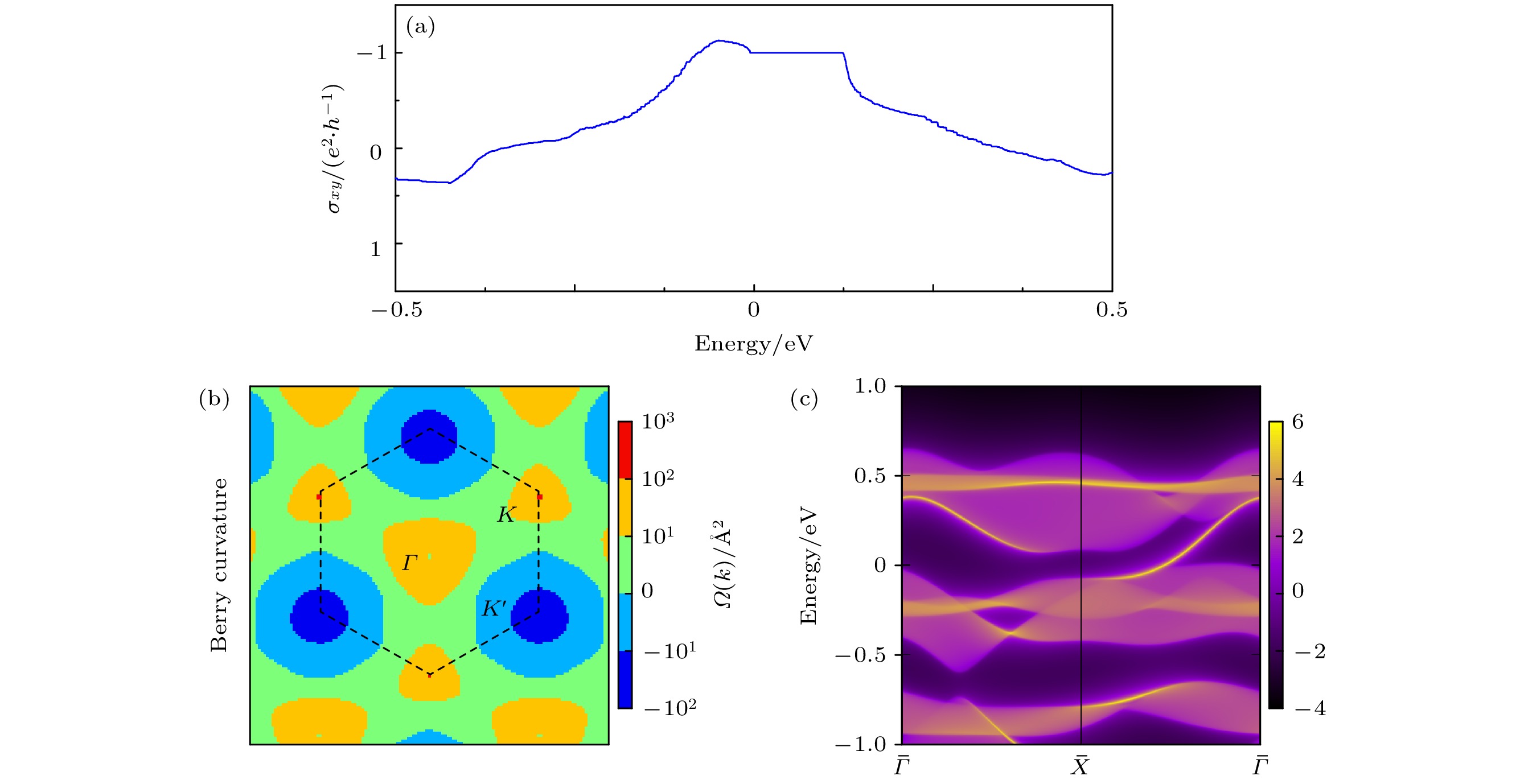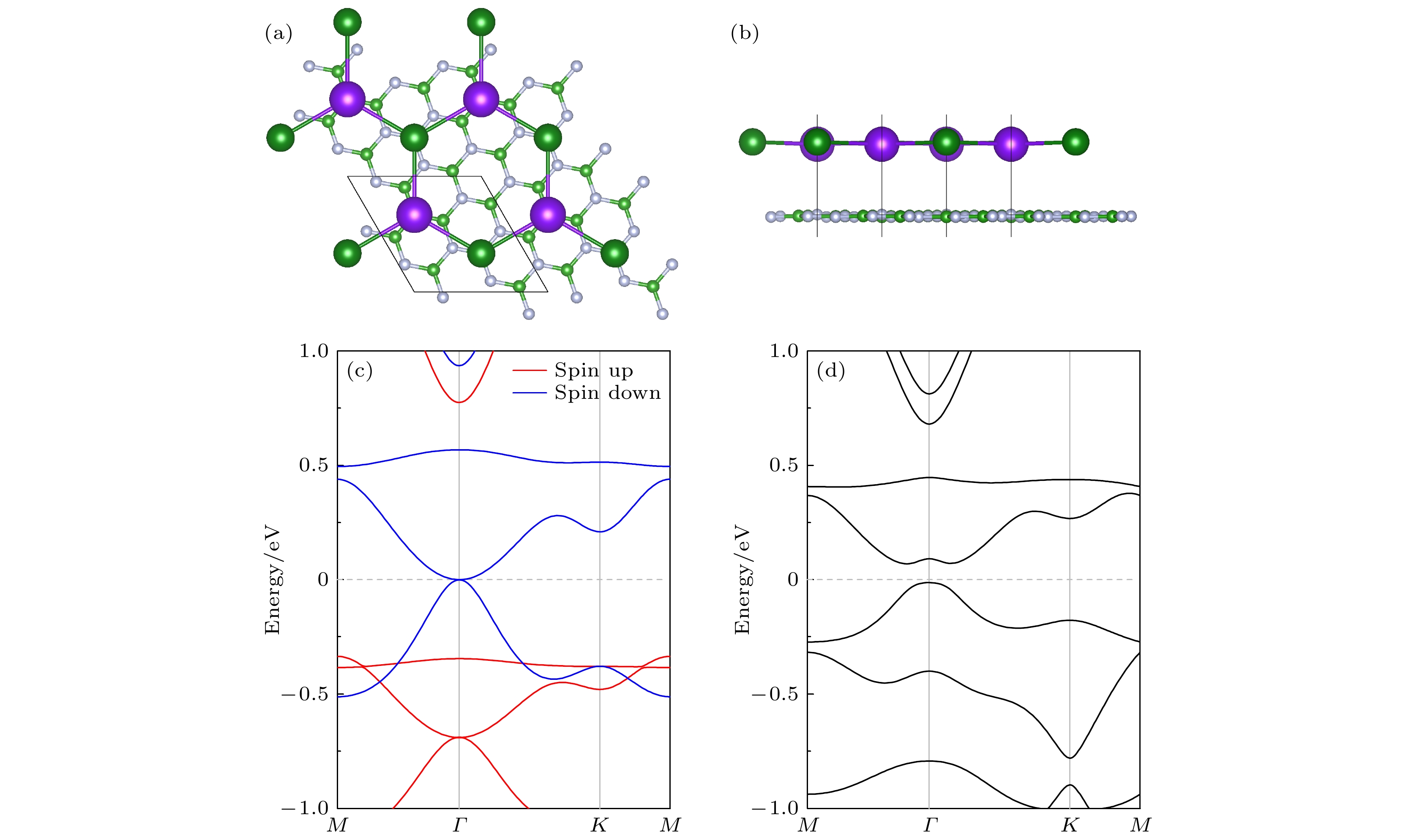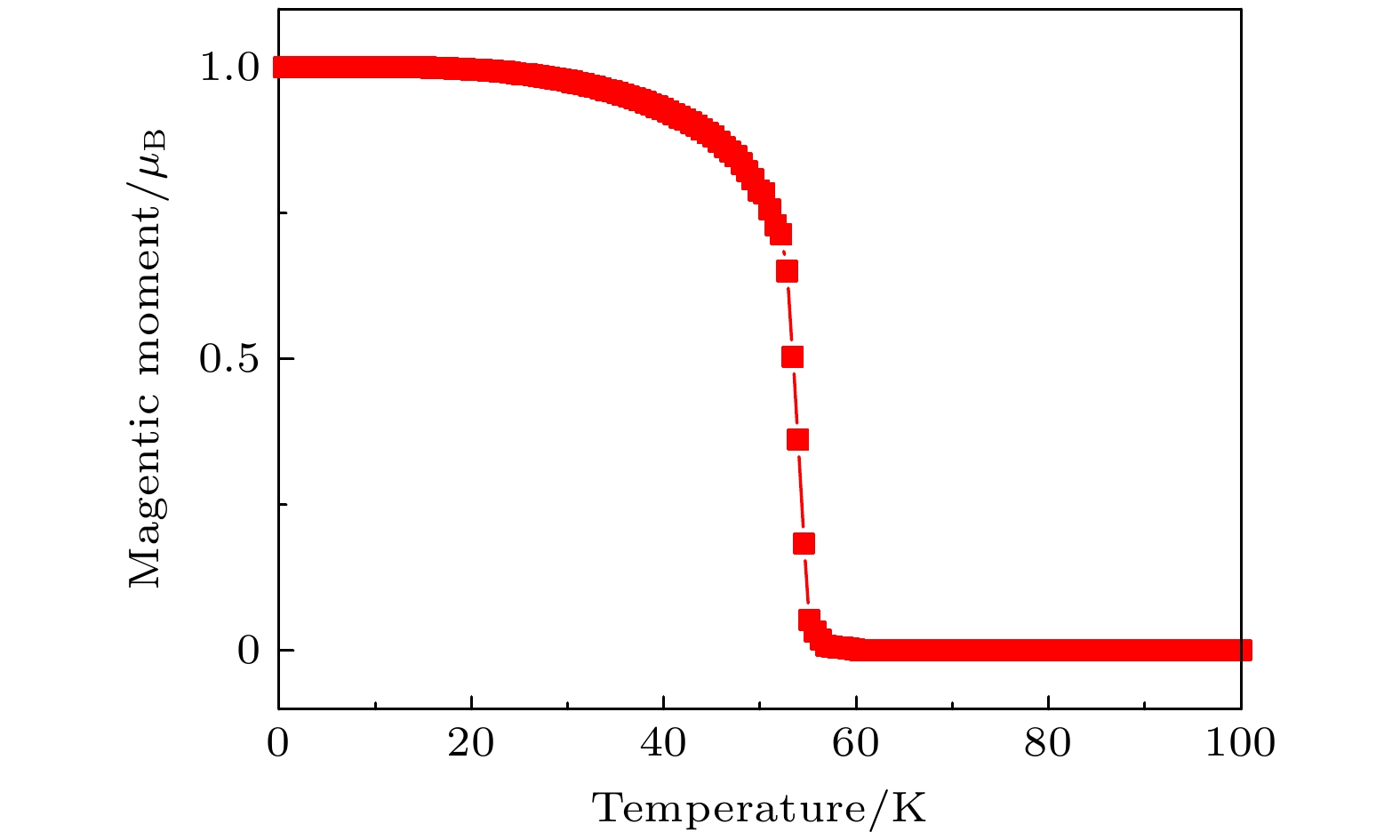-
具有巨大应用潜力的二维材料在纳米技术领域引起了人们极大的研究兴趣. 基于第一性原理计算, 本文预测了二维六角晶格BaPb体系具有室温量子反常霍尔效应. 体系磁基态是铁磁半金属态, 并且自旋极化的Pb-p轨道导致体系的时间反演对称性破缺. 具有非零Chern数(C = 1)的单层BaPb中非平庸拓扑性来源于全自旋极化的px,y轨道形成的二次型非狄拉克能带. 不同于之前报道的pz轨道形成的狄拉克拓扑态很容易被衬底破坏, px,y轨道形成的σ键非常稳定. 当考虑自旋-轨道耦合作用时, 二次型的非狄拉克点打开了接近177.39 meV的非平庸带隙. 通过反常霍尔电导、陈数、贝里曲率和边缘态的计算, 证实了BaPb非平庸的拓扑性. 此外, 体系还表现出每个单元52.01 meV的大磁晶各向异性能.The quantum anomalous Hall effect is an intriguing quantum state that exhibits chiral edge states in the absence of a magnetic field. The chiral edge states are topologically protected and robust against electron scattering, which possesses great potential applications in designing low energy consumption and dissipation less spintronic devices. The experimental conditions are required to be very high, such as extremely low temperature (< 100 mK) due to the small band gap and the greatly accurate control of the extrinsic impurities. These greatly hinder their devices from being put into applications further. Hence, it would be meaningful to search for a new Chern insulator with a large band gap and high Curie temperature. According to the first-principles calculations, we predict the room temperature quantum anomalous Hall effect in the monolayer BaPb. The nontrivial topology of this new type of ferroelectric semi-metal material derives from fully spin-polarized quadratic non-Dirac bands. The quantum anomalous Hall effect can be realized in the monolayer BaPb with fully spin-polarized quadratic px,y non-Dirac bands with the nonzero Chern number (C = 1). Because of the trigonal symmetry of monolayer BaPb material, these bands composed of px,y orbitals are at the
$ \varGamma $ point, which is different from the Dirac state formed by the pz orbital reported previously. In addition, it can still retain its original topological properties even if strongly hybridized with the substrate. The calculated phonon spectrum shows no imaginary frequency in the entire Brillouin zone, indicating that the monolayer BaPb system is dynamically stable. By using Monte Carlo simulation, we determine the Curie temperature of BaPb monolayer toreach up to 378 K. We also calculate the magnetic anisotropy energy of the BaPb cell, defined as$ \Delta E={E_{100}}-{E_{001}} $ . Here, we consider two magnetization easy-axis directions, [100] and [001]. To our surprise, the MAE of monolayer BaPb is as high as 52.01 meV/cell by considering the spin-orbit coupling effect. Furthermore, the nontrivial band gap is opened with a magnitude of 177.39 meV when the spin-orbit coupling effect is included. The calculations of Berry curvature and edge states further prove that the monolayer BaPb system can realize the quantum anomalous Hall state. This discovery indicates that the monolayer BaPb materials can be used as a candidate for quantum anomalous Hall effect materials, thereby promoting the development of spintronics.-
Keywords:
- quantum anomalous Hall effect /
- quadratic non-Dirac bands /
- ferromagnetic half-metallicity /
- first-principle
[1] Lu J M, Zheliuk O, Leermakers I, Yuan N F Q, Zeitler U, Lwa K T, Ye J T 2015 Science 350 1353
 Google Scholar
Google Scholar
[2] Gong C, Zhang X 2019 Science 363 eaav4450
[3] Deng Y, Yu Y, Shi M Z, Guo Z, Xu Z, Wang J, Chen X H, Zhang Y 2020 Science 367 895
[4] 高艺璇, 张礼智, 张余洋, 杜世萱 2018 物理学报 67 238101
 Google Scholar
Google Scholar
Gao Y X, Zhang L Z, Zhang Y Y, Du S X 2018 Acta Phys. Sin. 67 238101
 Google Scholar
Google Scholar
[5] 徐依全, 王聪 2020 物理学报 69 184216
 Google Scholar
Google Scholar
Xu Y Q, Wang C 2020 Acta Phys. Sin. 69 184216
 Google Scholar
Google Scholar
[6] 孙真昊, 管鸿明, 付雷, 沈波, 唐宁 2021 物理学报 70 027302
Sun Z H, Guan H M, Fu L, Shen B, Tang N 2021 Acta Phys. Sin. 70 027302
[7] Haldane F D M 1988 Phys. Rev. Lett. 61 2015
 Google Scholar
Google Scholar
[8] Liu C X, Qi X L, Dai X, Fang Z, Zhang S C 2008 Phys. Rev. Lett. 101 146802
 Google Scholar
Google Scholar
[9] Zhang H, Lazo C, Blügel S, Heinze S, Mokrousov Y 2012 Phys. Rev. Lett. 108 056802
 Google Scholar
Google Scholar
[10] Hu J, Zhu Z, Wu R 2015 Nano Lett. 15 2074
 Google Scholar
Google Scholar
[11] Li P, Li X, Zhao W, Chen H, Chen M X, Guo Z X, Feng J, Gong X G, MacDonald A H 2017 Nano Lett. 17 6195
 Google Scholar
Google Scholar
[12] Li P 2019 Phys. Chem. Chem. Phys. 21 6712
 Google Scholar
Google Scholar
[13] Onoda M, Nagaosa N 2003 Phys. Rev. Lett. 90 206601
 Google Scholar
Google Scholar
[14] Hasan M Z, Kane C L 2010 Rev. Mod. Phys. 82 3045
 Google Scholar
Google Scholar
[15] Luo W, Xiang H 2015 Nano Lett. 15 3230
 Google Scholar
Google Scholar
[16] Checkelsky J G, Yoshimi R, Tsukazaki A, Takahashi K S, Kozuka Y, Falson J, Kawaski M, Tokura Y 2014 Nat. Phys. 10 731
 Google Scholar
Google Scholar
[17] Bestwick A J, Fox E J, Kou X, Pan L, Wang K L, Goldhaber-Gordon D 2015 Phys. Rev. Lett. 114 187201
 Google Scholar
Google Scholar
[18] Chang C Z, Zhao W, Kim D Y, Zhang H, Assaf B A, Heiman D, Zhang S C, Liu C, Chan M H W, Moodera J S 2015 Nat. Mater. 14 473
 Google Scholar
Google Scholar
[19] Ou Y, Liu C, Jiang G, Feng Y, Zhao D, Wu W, Wang X X, Li W, Song C, Wang L L, Wang W, Wu W, Wang Y, He K, Ma X C, Xue Q K 2018 Adv. Mater. 30 1703062
 Google Scholar
Google Scholar
[20] Otrokov M M, Rusinov I P, Blanco-Rey M, Hoffmann M, Vyazovskaya A Y, Eremeev S V, Ernst A, Echenique P M, Arnau A, Chulkov E V 2019 Phys. Rev. Lett. 122 107202
 Google Scholar
Google Scholar
[21] Zhang D, Shi M, Zhu T, Xing D, Zhang H, Wang J 2019 Phys. Rev. Lett. 122 206401
 Google Scholar
Google Scholar
[22] Otrokov M M, Klimovskikh I I, Chulkov E V 2019 Nature 576 416
 Google Scholar
Google Scholar
[23] Wang S, Yu Z, Liu Y, Jiao Y, Guan S, Sheng X, Yang S A 2019 Phys. Rev. Materials 3 084201
 Google Scholar
Google Scholar
[24] Kong X, Li L, Leenaerts O, Wang W, Liu X, Peeters F M 2018 Nanoscale 10 8153
 Google Scholar
Google Scholar
[25] Gong C, Li L, Li Z, Ji H, Stern A, Xia Y, Cao T, Bao W, Wang C, Wang Y, Qiu Z Q, Cava R J, Louie S G, Xia J, Zhang X 2017 Nature 546 265
 Google Scholar
Google Scholar
[26] Huang B, Clark G, Navarro-Moratalla E, Klein D R, Cheng R, Seyler K L, Zhong D, Schmidgall E, McGuire M A, Cobden D H, Yao W, Xiao D, Jarillo-Herrero P, Xu X 2017 Nature 546 270
 Google Scholar
Google Scholar
[27] Zhang Z, Shang J, Jiang C, Rasmita A, Gao W, Yu T 2019 Nano Lett. 19 3138
 Google Scholar
Google Scholar
[28] Kresse G, Hafner J 1993 Phys. Rev. B 47 558
 Google Scholar
Google Scholar
[29] Blochl P E 1994 Phys. Rev. B 50 17953
 Google Scholar
Google Scholar
[30] Dudarev S L, Botton G A, Savrasov S Y, Humphreys C J, Sutton A P 1998 Phys. Rev. B 57 1505
 Google Scholar
Google Scholar
[31] Perdew J P, Burke K, Ernzerhof M 1996 Phys. Rev. Lett. 77 3865
 Google Scholar
Google Scholar
[32] Mostofi A A, Yates J R, Lee Y S, Souza I, Vanderbilt D, Marzari N 2008 Comput. Phys. Commun. 178 685
 Google Scholar
Google Scholar
[33] Wu Q S, Zhang S N, Song H F, Troyer M, Suluyanov A A 2018 Comput. Phys. Commun. 224 405
 Google Scholar
Google Scholar
[34] Zhuang H L, Henning R G 2013 Appl. Phys. Lett. 103 212102
 Google Scholar
Google Scholar
[35] Evans R F, Fan W J, Chureemart P, Ostler T A, Ellis M O, Chantrell R W 2014 J. Phys. Condens. Matter. 26 103202
 Google Scholar
Google Scholar
[36] Thouless D J, Kohmoto M, Nightingale M P, den Nijs M 1982 Phys. Rev. Lett. 49 405
 Google Scholar
Google Scholar
[37] Zhang R W, Zhang C W, Ji W X, Yan S S, Yao Y G 2017 Nanoscale 9 8207
 Google Scholar
Google Scholar
[38] Reis F, Li G, Dudy L, Bauernfeind M, Glass S, Hanke W, Thomale R, Schafer J, Claessen R 2017 Science 357 287
 Google Scholar
Google Scholar
-
图 2 单分子层BaPb的铁磁构型(a)和反铁磁构型(b); (c)利用蒙特卡罗模拟得到的单层BaPb的磁矩与温度的关系
Fig. 2. Two magnetic configurations for monolayer BaPb: (a) Ferromagnetic; (b) antiferromagnetic. (c) The average magnetic moment per unit cell with respect to temperature calculated for monolayer BaPb obtained by using Monte Carlo simulations.
图 5 (a) 反常霍尔电导率随费米能级移动的变化; (b) 动量空间中带有SOC的Berry曲率; (c) 计算得到的单层BaPb半无限片的边缘状态
Fig. 5. (a) Anomalous Hall conductivity when the Fermi level is shifted around the original Fermi level; (b) the Berry curvature with SOC in the momentum space; (c) calculated edge state of a semi-infinite sheet for monolayer BaPb.
图 6 (a), (b) h-BN/BaPb异质结(h-BN/BaPb)体系中单分子层BaPb的结构晶体结构的俯视图和侧视图; (c) h-BN/BaPb异质结自旋极化能带结构; (d) 考虑SOC效应时h-BN/BaPb异质结体系中单分子层BaPb的带结构(考虑SOC效应)
Fig. 6. Crystal structure of monolayer BaPb in the h-BN/BaPb heterostructure system: (a) Top and (b) side views. Here, the black solid lines denote the unit cell. (c) Spin-polarized band structure of h-BN/BaPb heterostructure; (d) the band structures (including SOC) of monolayer BaPb in the h-BN/BaPb heterostructure system.
-
[1] Lu J M, Zheliuk O, Leermakers I, Yuan N F Q, Zeitler U, Lwa K T, Ye J T 2015 Science 350 1353
 Google Scholar
Google Scholar
[2] Gong C, Zhang X 2019 Science 363 eaav4450
[3] Deng Y, Yu Y, Shi M Z, Guo Z, Xu Z, Wang J, Chen X H, Zhang Y 2020 Science 367 895
[4] 高艺璇, 张礼智, 张余洋, 杜世萱 2018 物理学报 67 238101
 Google Scholar
Google Scholar
Gao Y X, Zhang L Z, Zhang Y Y, Du S X 2018 Acta Phys. Sin. 67 238101
 Google Scholar
Google Scholar
[5] 徐依全, 王聪 2020 物理学报 69 184216
 Google Scholar
Google Scholar
Xu Y Q, Wang C 2020 Acta Phys. Sin. 69 184216
 Google Scholar
Google Scholar
[6] 孙真昊, 管鸿明, 付雷, 沈波, 唐宁 2021 物理学报 70 027302
Sun Z H, Guan H M, Fu L, Shen B, Tang N 2021 Acta Phys. Sin. 70 027302
[7] Haldane F D M 1988 Phys. Rev. Lett. 61 2015
 Google Scholar
Google Scholar
[8] Liu C X, Qi X L, Dai X, Fang Z, Zhang S C 2008 Phys. Rev. Lett. 101 146802
 Google Scholar
Google Scholar
[9] Zhang H, Lazo C, Blügel S, Heinze S, Mokrousov Y 2012 Phys. Rev. Lett. 108 056802
 Google Scholar
Google Scholar
[10] Hu J, Zhu Z, Wu R 2015 Nano Lett. 15 2074
 Google Scholar
Google Scholar
[11] Li P, Li X, Zhao W, Chen H, Chen M X, Guo Z X, Feng J, Gong X G, MacDonald A H 2017 Nano Lett. 17 6195
 Google Scholar
Google Scholar
[12] Li P 2019 Phys. Chem. Chem. Phys. 21 6712
 Google Scholar
Google Scholar
[13] Onoda M, Nagaosa N 2003 Phys. Rev. Lett. 90 206601
 Google Scholar
Google Scholar
[14] Hasan M Z, Kane C L 2010 Rev. Mod. Phys. 82 3045
 Google Scholar
Google Scholar
[15] Luo W, Xiang H 2015 Nano Lett. 15 3230
 Google Scholar
Google Scholar
[16] Checkelsky J G, Yoshimi R, Tsukazaki A, Takahashi K S, Kozuka Y, Falson J, Kawaski M, Tokura Y 2014 Nat. Phys. 10 731
 Google Scholar
Google Scholar
[17] Bestwick A J, Fox E J, Kou X, Pan L, Wang K L, Goldhaber-Gordon D 2015 Phys. Rev. Lett. 114 187201
 Google Scholar
Google Scholar
[18] Chang C Z, Zhao W, Kim D Y, Zhang H, Assaf B A, Heiman D, Zhang S C, Liu C, Chan M H W, Moodera J S 2015 Nat. Mater. 14 473
 Google Scholar
Google Scholar
[19] Ou Y, Liu C, Jiang G, Feng Y, Zhao D, Wu W, Wang X X, Li W, Song C, Wang L L, Wang W, Wu W, Wang Y, He K, Ma X C, Xue Q K 2018 Adv. Mater. 30 1703062
 Google Scholar
Google Scholar
[20] Otrokov M M, Rusinov I P, Blanco-Rey M, Hoffmann M, Vyazovskaya A Y, Eremeev S V, Ernst A, Echenique P M, Arnau A, Chulkov E V 2019 Phys. Rev. Lett. 122 107202
 Google Scholar
Google Scholar
[21] Zhang D, Shi M, Zhu T, Xing D, Zhang H, Wang J 2019 Phys. Rev. Lett. 122 206401
 Google Scholar
Google Scholar
[22] Otrokov M M, Klimovskikh I I, Chulkov E V 2019 Nature 576 416
 Google Scholar
Google Scholar
[23] Wang S, Yu Z, Liu Y, Jiao Y, Guan S, Sheng X, Yang S A 2019 Phys. Rev. Materials 3 084201
 Google Scholar
Google Scholar
[24] Kong X, Li L, Leenaerts O, Wang W, Liu X, Peeters F M 2018 Nanoscale 10 8153
 Google Scholar
Google Scholar
[25] Gong C, Li L, Li Z, Ji H, Stern A, Xia Y, Cao T, Bao W, Wang C, Wang Y, Qiu Z Q, Cava R J, Louie S G, Xia J, Zhang X 2017 Nature 546 265
 Google Scholar
Google Scholar
[26] Huang B, Clark G, Navarro-Moratalla E, Klein D R, Cheng R, Seyler K L, Zhong D, Schmidgall E, McGuire M A, Cobden D H, Yao W, Xiao D, Jarillo-Herrero P, Xu X 2017 Nature 546 270
 Google Scholar
Google Scholar
[27] Zhang Z, Shang J, Jiang C, Rasmita A, Gao W, Yu T 2019 Nano Lett. 19 3138
 Google Scholar
Google Scholar
[28] Kresse G, Hafner J 1993 Phys. Rev. B 47 558
 Google Scholar
Google Scholar
[29] Blochl P E 1994 Phys. Rev. B 50 17953
 Google Scholar
Google Scholar
[30] Dudarev S L, Botton G A, Savrasov S Y, Humphreys C J, Sutton A P 1998 Phys. Rev. B 57 1505
 Google Scholar
Google Scholar
[31] Perdew J P, Burke K, Ernzerhof M 1996 Phys. Rev. Lett. 77 3865
 Google Scholar
Google Scholar
[32] Mostofi A A, Yates J R, Lee Y S, Souza I, Vanderbilt D, Marzari N 2008 Comput. Phys. Commun. 178 685
 Google Scholar
Google Scholar
[33] Wu Q S, Zhang S N, Song H F, Troyer M, Suluyanov A A 2018 Comput. Phys. Commun. 224 405
 Google Scholar
Google Scholar
[34] Zhuang H L, Henning R G 2013 Appl. Phys. Lett. 103 212102
 Google Scholar
Google Scholar
[35] Evans R F, Fan W J, Chureemart P, Ostler T A, Ellis M O, Chantrell R W 2014 J. Phys. Condens. Matter. 26 103202
 Google Scholar
Google Scholar
[36] Thouless D J, Kohmoto M, Nightingale M P, den Nijs M 1982 Phys. Rev. Lett. 49 405
 Google Scholar
Google Scholar
[37] Zhang R W, Zhang C W, Ji W X, Yan S S, Yao Y G 2017 Nanoscale 9 8207
 Google Scholar
Google Scholar
[38] Reis F, Li G, Dudy L, Bauernfeind M, Glass S, Hanke W, Thomale R, Schafer J, Claessen R 2017 Science 357 287
 Google Scholar
Google Scholar
计量
- 文章访问数: 7669
- PDF下载量: 158
- 被引次数: 0
















 下载:
下载:
